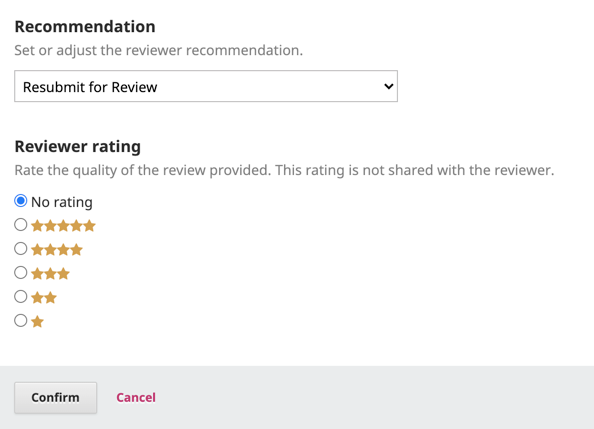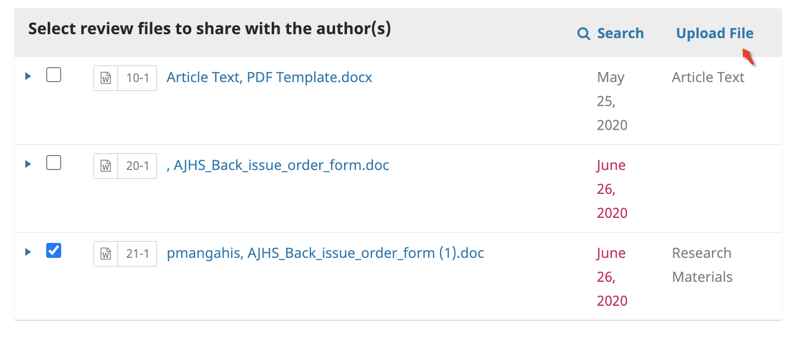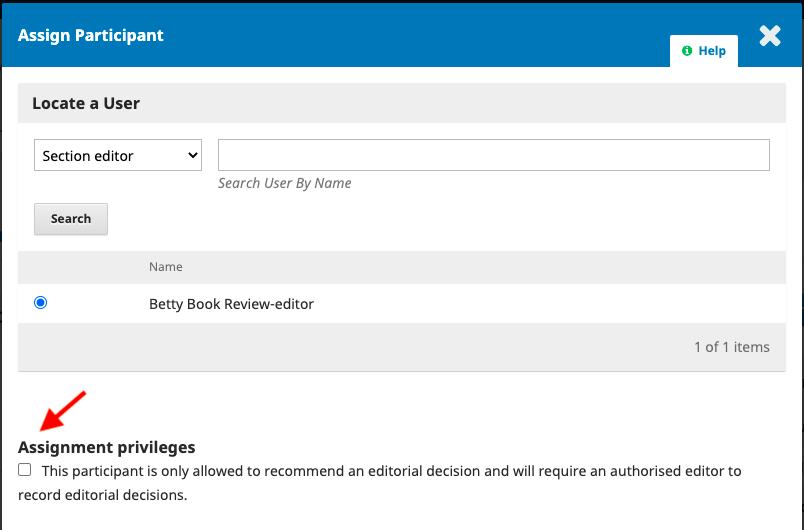
Once a recommendation has been submitted by a reviewer, the review is essentially closed. A reviewer will not be able to make this change on their own. However, an editor (or section editor) can change the reviewer recommendation on their behalf.
To make the recommendation change, the Editor will need to click the blue arrow beside the reviewer’s name followed by Review Details.

Change the recommendation on the drop down menu and click Confirm.

Once a review has been submitted, the review is essentially closed. The review file cannot be replaced with a new one by the reviewer. However, the editor can provide the author with the most recent version when sending the decision email.
To do this, the editor can upload a new attachment to their decision email.

If an editor opens a new round of review before the previous round was completed, there is no way to cancel or reverse it, other than through editing the database, which we caution against since it compromises the editorial history of the submission. Reviewers invited to the previous round will not be able to access the previous round once the new round is open. The editors will need to ignore the previous round and continue working in the new round, completing the reviews and recording an editorial decision in the new round. There is no minimum or maximum number of reviewers required for each round. We recommend that the editor add a note in the submission that explains the situation.
It’s most likely that when you assigned yourself or were assigned by another editor, the assignment privilege checkbox was set to only allow you to recommend a decision. If this happens on a self-assignment (or if you have the global permissions of a journal editor/manager), simply navigate to the list of Participants, click on the blue triangle next to your name, and click Edit. Make sure the checkbox limiting assignment privileges is unchecked.

You can also unassign and re-assign yourself as the editor, being careful not to accidentally check this box again.

Once you do this, you should be able to record a decision. If you cannot change your own assignment privileges, ask the person who assigned you to do this. If this happens for another editor, you can either record the decision on their behalf or edit their privilege.
It is not possible to customize the Reviewer recommendations through OJS or OMP configuration settings. There is an open GitHub ticket to improve this functionality for future releases.
You can, however, use the Custom Locale plugin to make minor wording changes of the Reviewer recommendation options. For example, you could change “Accept” to “Accept with minor changes.” The Custom Locale Plugin offers an alternative to modifying the files on your server, by allowing you to set journal-by-journal overrides for locale key translations. Instructions on how to use the Custom Locale Plugin are available in the PKP Translating Guide.
You cannot delete or add recommendations with the Custom Locale Plugin.
You can access a log of all events and emails sent on a particular submission by opening the submission and clicking “Activity Log” (or “Editorial History” in older versions of OJS and OMP).
If the Activity Log shows the message was sent but the user did not receive it, send test emails to determine whether the issue is specific to a user, submission, or action.
For further email troubleshooting, see the PKP Administrator’s Guide.
First, ensure that the galley file is uploaded into the correct location. Only files uploaded under the “Publication” tab will be displayed to the end-reader.
Whether or not the galley file links appear on the issue table of contents page depends on which component type the galley file is and how the component type has been configured. If the link is not appearing on the table of contents, it is probably because it is a component type that has been configured as Dependent or Supplementary.
See the Production and Publication chapter and Workflow Settings chapter in Learning OJS 3 for instructions on how to edit and configure component types so the galley file link will appear in the table of contents.
If the HTML galley is triggering a download, instead of displaying in the browser window, check that the HTML Article Galley plugin is active. Go to Settings > Website > Plugins, and ensure that the HTML Article Galley plugin is installed, up-to-date, and enabled.
If you have further issues, ask your Systems Administrator to check your server and filetype configurations. OJS, OMP, and OPS use three methods to determine a filetype, in the following order:
mime_content_type function, which uses your system’s magic.mime file (this method is deprecated)finfo_... suite of functions (which replaces mime_content_type as the preferred method)file -bi [filename here]Problems may occur if:
Additionally, you may be encountering problems due to malformed files. If you are having trouble having your HTML files recognized, you may want to run them through HTML-Tidy or otherwise ensure that they are valid HTML. HTML files created by word processors in particular may have a hard time being recognized as HTML.
You may also want to search the forums for the keywords “magic mime” or for “mimetype” – many users have had this problem, and there are several discussions on how to solve it. See also this forum article.
As of OJS 3.3, articles must first be declined before they can be deleted. Incomplete submissions must also be completed before they be declined. You may need to enter temporary / filler metadata and upload a sample file to complete a submission so that it can be declined and deleted.
Depending on the workflow stage that the submission is in, a Journal Editor or Journal Manager may need to return to an earlier stage (such as Submission) and select “Change decision.” Once the submission is declined, follow the steps below to delete the submission.
Note: Be cautious when deleting published items from your site. Once items are published, they become part of the “scholarly record.” Users may have found the work, downloaded it, and cited it. Removing the item after publication interrupts the flow of information that scholars rely on to do further research on a subject. If a user asks for an item to be removed, be sure to verify the reason for the removal and explore alternatives before removing the item completely. Where possible, preserve some of the item metadata, such as the title, author name, and abstract, and include a note that the item has been removed so that users can see that the item existed at one time.
You may want to disable submissions if your journal is no longer publishing or you only use OJS to publish your content.
To disable new submissions to the journal, you will need to be in the Journal Manager role.
If you are using OJS 3.0, 3.1, or 3.2, you can do this by restricting section submitters, as described in the Learning OJS 3 guide: Journal Settings > Sections.
If you are using OJS 3.3 or newer you can more easily disable submissions to the journal as a whole and to particular sections. See the Workflow Settings chapter of Learning OJS 3.